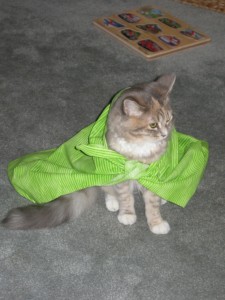 We talked about training cats yesterday and I asked if you’d taught your cat anything. I believe that most of us have rituals with our cats and routines that involve them. Is that training or conditioning? What is the difference? Does it matter? I mean, if you have a sweet routine with your cat that the two of you enjoy, it really doesn’t matter if it’s training or conditioning. It’s sweet. And it helps to endear you to your cat and vice versa.
We talked about training cats yesterday and I asked if you’d taught your cat anything. I believe that most of us have rituals with our cats and routines that involve them. Is that training or conditioning? What is the difference? Does it matter? I mean, if you have a sweet routine with your cat that the two of you enjoy, it really doesn’t matter if it’s training or conditioning. It’s sweet. And it helps to endear you to your cat and vice versa.
That’s the theme of today’s blog post. But first, I’d like to share a link to one of my recipes. Yes, I said recipe. It’s off topic, I know. But Kaycee at My Crafty Zoo expressed an interest in my Klepto Cat Mysteries. She’s a reviewer of books and other things. She posts reviews, giveaways and recipes. So I submitted a recipe for Quinoa Squash Soup. Here it is if you’re interested: https://mycraftyzoo.com/quinoa-squash-soup/
In the meantime, here are some of the things I’ve enjoyed with my cats that may be 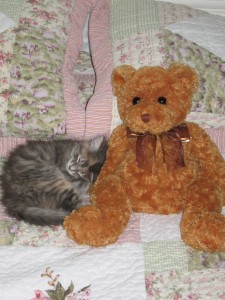 considered conditioning, training, or simply habit. My Himalayan, Katy, used to tuck me into bed. She’d come and “get me” when it was my usual bedtime, accompany me to the bathroom, then the bedroom and hop up onto the bed with me. She’d lay on my pillow for a few minutes with one paw on my shoulder. After several minutes, she’d take off to parts unknown. It was like a doting mother putting her baby to bed.
considered conditioning, training, or simply habit. My Himalayan, Katy, used to tuck me into bed. She’d come and “get me” when it was my usual bedtime, accompany me to the bathroom, then the bedroom and hop up onto the bed with me. She’d lay on my pillow for a few minutes with one paw on my shoulder. After several minutes, she’d take off to parts unknown. It was like a doting mother putting her baby to bed.
Winfield, our white odd-eye cat, always checked his water and food bowls when we started closing down the house, lights, etc. preparing for bed. If they were low, he’d sit next to them and wait for us to walk by and notice. I’d say he had us trained.
Lily comes into the living room about 15 minutes before bedtime and stares at me with big eyes. When I head in to go to bed, she follows me through my night-time routine, watching, waiting. As soon as I get into bed, she takes one last bite of kibbles and sip of water, then joins me.
Sophie, on the other hand, waits and watches for me to leave my spot on the sofa, then she curls up there for a couple of hours sleep.
 Of course, every cat I’ve had quickly learns my wake-up time and routine. And if I don’t wake up on schedule, they will start a plan to wake me. Does your cat do that?
Of course, every cat I’ve had quickly learns my wake-up time and routine. And if I don’t wake up on schedule, they will start a plan to wake me. Does your cat do that?
I find it interesting that a cat will change her routine from time to time. Lily, for example, will come into my office after eating in the morning and curl up in my lap. I call it our cuddle time. She’ll do that for weeks, then stop all of a sudden. I used to think it was the weather—if it was chilly, she’d cuddle, if not, she wouldn’t. This week, however, we’ve had some extreme heat (for this time of year). And she’s been requesting early morning lap time. We’re also having workers around the house during the day this week and that scares the bejeebers out of her. So she might be seeking comfort by curling up in my lap.
Experts say it’s good to establish a routine when you have cats. It can actually help you to 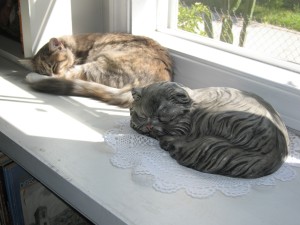 train them. I guess you might say that I’ve trained Lily in a way. She’s a beggar. Well, that’s my fault and I’ll take the blame. Lily LOVES food and eating. But it wasn’t always that way. She had a period where she stopped eating. She was a very sick little girl. And we tried every ploy and enticing food we could think of (as directed by a team of veterinarians) to get her to eat. I think it was then that we created our little monster glutton. Now she wants every morsel of food in sight, including whatever I’m eating.
train them. I guess you might say that I’ve trained Lily in a way. She’s a beggar. Well, that’s my fault and I’ll take the blame. Lily LOVES food and eating. But it wasn’t always that way. She had a period where she stopped eating. She was a very sick little girl. And we tried every ploy and enticing food we could think of (as directed by a team of veterinarians) to get her to eat. I think it was then that we created our little monster glutton. Now she wants every morsel of food in sight, including whatever I’m eating.
At least I’ve trained her or conditioned her to sit and wait until I’m almost finished. If it is something okay for her to have (no heavily seasoned food, etc.), I’ll leave a tiny morsel for her at the edge of my plate and she gently reaches over and takes it only when I give her the okay. I love that little fur-girl.
Here’s an interesting article on the value of routines for cats.
https://www.homewardtrails.org/resources/cats/routine-for-cats/#.WsoCGJdlCUk
 Did you have a cat in your dorm room when you went to college? More and more colleges are assisting students in making the transition from home to the higher education community by allowing them to bring their pets. Colleges in North Carolina, Colorado, Florida, Missouri, and other states have opened their doors to pets and they allow most any small animal. One university even housed a pair of ducks for a pair of roommates one year.
Did you have a cat in your dorm room when you went to college? More and more colleges are assisting students in making the transition from home to the higher education community by allowing them to bring their pets. Colleges in North Carolina, Colorado, Florida, Missouri, and other states have opened their doors to pets and they allow most any small animal. One university even housed a pair of ducks for a pair of roommates one year.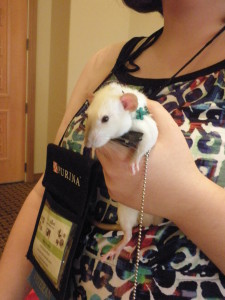 disabilities. But for many, the idea of welcoming pets for the general population is new. So if your child or grandchild is heading off to college and having trouble with the idea of leaving the family, you might look into the possibility of him or her packing up the family dog or cat to keep them company.
disabilities. But for many, the idea of welcoming pets for the general population is new. So if your child or grandchild is heading off to college and having trouble with the idea of leaving the family, you might look into the possibility of him or her packing up the family dog or cat to keep them company.
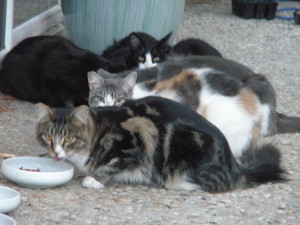 Too few cats? That’s not generally a problem we hear about these days. Instead, we read articles and see news reports of neighborhoods and cities and especially shelters being overrun by unwanted cats. But evidently there is a cat shortage in London. Suddenly, more and more people are wanting cats of their own.
Too few cats? That’s not generally a problem we hear about these days. Instead, we read articles and see news reports of neighborhoods and cities and especially shelters being overrun by unwanted cats. But evidently there is a cat shortage in London. Suddenly, more and more people are wanting cats of their own. We talked about training cats yesterday and I asked if you’d taught your cat anything. I believe that most of us have rituals with our cats and routines that involve them. Is that training or conditioning? What is the difference? Does it matter? I mean, if you have a sweet routine with your cat that the two of you enjoy, it really doesn’t matter if it’s training or conditioning. It’s sweet. And it helps to endear you to your cat and vice versa.
We talked about training cats yesterday and I asked if you’d taught your cat anything. I believe that most of us have rituals with our cats and routines that involve them. Is that training or conditioning? What is the difference? Does it matter? I mean, if you have a sweet routine with your cat that the two of you enjoy, it really doesn’t matter if it’s training or conditioning. It’s sweet. And it helps to endear you to your cat and vice versa. considered conditioning, training, or simply habit. My Himalayan, Katy, used to tuck me into bed. She’d come and “get me” when it was my usual bedtime, accompany me to the bathroom, then the bedroom and hop up onto the bed with me. She’d lay on my pillow for a few minutes with one paw on my shoulder. After several minutes, she’d take off to parts unknown. It was like a doting mother putting her baby to bed.
considered conditioning, training, or simply habit. My Himalayan, Katy, used to tuck me into bed. She’d come and “get me” when it was my usual bedtime, accompany me to the bathroom, then the bedroom and hop up onto the bed with me. She’d lay on my pillow for a few minutes with one paw on my shoulder. After several minutes, she’d take off to parts unknown. It was like a doting mother putting her baby to bed. Of course, every cat I’ve had quickly learns my wake-up time and routine. And if I don’t wake up on schedule, they will start a plan to wake me. Does your cat do that?
Of course, every cat I’ve had quickly learns my wake-up time and routine. And if I don’t wake up on schedule, they will start a plan to wake me. Does your cat do that? train them. I guess you might say that I’ve trained Lily in a way. She’s a beggar. Well, that’s my fault and I’ll take the blame. Lily LOVES food and eating. But it wasn’t always that way. She had a period where she stopped eating. She was a very sick little girl. And we tried every ploy and enticing food we could think of (as directed by a team of veterinarians) to get her to eat. I think it was then that we created our little monster glutton. Now she wants every morsel of food in sight, including whatever I’m eating.
train them. I guess you might say that I’ve trained Lily in a way. She’s a beggar. Well, that’s my fault and I’ll take the blame. Lily LOVES food and eating. But it wasn’t always that way. She had a period where she stopped eating. She was a very sick little girl. And we tried every ploy and enticing food we could think of (as directed by a team of veterinarians) to get her to eat. I think it was then that we created our little monster glutton. Now she wants every morsel of food in sight, including whatever I’m eating.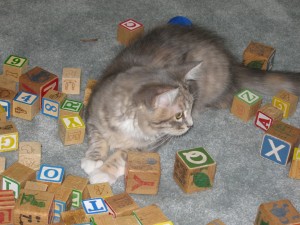 Yesterday we talked about the fact that there’s more research going on related to dogs than cats. One theory is that scientists shy away from working with cats because they can’t be trained. Say what? Then why do you suppose there are so many products out there designed to train a cat? There are toilet kits to teach cats to use the human toilet, for example. Heck, even the litter box and kitty litter can be training tools, as are cat toys designed to encourage a cat to replicate a hunting instinct (for those who may not have the instinct innately).
Yesterday we talked about the fact that there’s more research going on related to dogs than cats. One theory is that scientists shy away from working with cats because they can’t be trained. Say what? Then why do you suppose there are so many products out there designed to train a cat? There are toilet kits to teach cats to use the human toilet, for example. Heck, even the litter box and kitty litter can be training tools, as are cat toys designed to encourage a cat to replicate a hunting instinct (for those who may not have the instinct innately).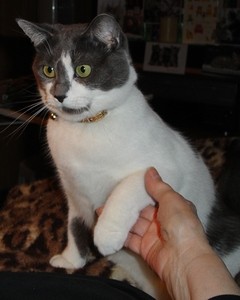 of before called target training. You use an object—a pencil or wooden spoon, for example, and touch it to the cat’s nose. When the target object touches her nose, she gets a treat. I imagine the purpose in this is to get the cat’s attention. Wow, that would be a challenge. The only time my cats pay attention to me is when I’m opening a can of cat food or rattling a package of their treats. Yes, they’re food trained! It’s time to eat and they come running. I rattle a treat bag and they’re under foot.
of before called target training. You use an object—a pencil or wooden spoon, for example, and touch it to the cat’s nose. When the target object touches her nose, she gets a treat. I imagine the purpose in this is to get the cat’s attention. Wow, that would be a challenge. The only time my cats pay attention to me is when I’m opening a can of cat food or rattling a package of their treats. Yes, they’re food trained! It’s time to eat and they come running. I rattle a treat bag and they’re under foot.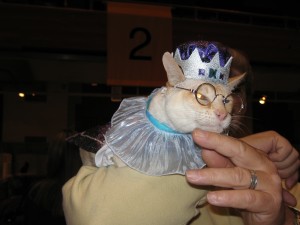 Yes, cats can be trained. Just look at the success Samantha Martin has had training cats for the Amazing Acro-Cat Circus. Here’s a great article about the Acro-Cat Circus and what Ms. Martin has contributed to the plight of homeless cats.
Yes, cats can be trained. Just look at the success Samantha Martin has had training cats for the Amazing Acro-Cat Circus. Here’s a great article about the Acro-Cat Circus and what Ms. Martin has contributed to the plight of homeless cats. 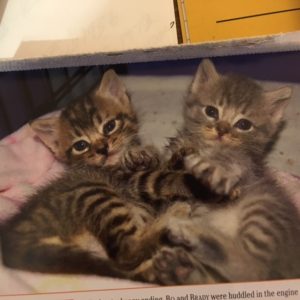 Even though it seems that the Internet has gone hog wild with videos of and information about cats, dogs still come out on top in most competition. For example, there are around 400 breeds of dogs and only about 40 cat breeds. And dogs are still studied more than cats are. According to researchers, dogs have been domesticated longer than cats—which actually should make cats more intriguing. Don’t you think so? Yes, more research is being done with regard to dog behavior, health, ailments, genetics, and so forth. While cats are chosen when it comes to researching certain diseases—cancer, for example, they just aren’t as interesting to most researchers for a variety of reasons.
Even though it seems that the Internet has gone hog wild with videos of and information about cats, dogs still come out on top in most competition. For example, there are around 400 breeds of dogs and only about 40 cat breeds. And dogs are still studied more than cats are. According to researchers, dogs have been domesticated longer than cats—which actually should make cats more intriguing. Don’t you think so? Yes, more research is being done with regard to dog behavior, health, ailments, genetics, and so forth. While cats are chosen when it comes to researching certain diseases—cancer, for example, they just aren’t as interesting to most researchers for a variety of reasons. Some say that cats are more difficult to study because they don’t cooperate. They don’t do what they’re told. Which is also why some of us are attracted to cats, don’t you think so? However, it may surprise you to know that cats can be trained. Stay tuned. That’s going to be my theme for tomorrow’s blog post.
Some say that cats are more difficult to study because they don’t cooperate. They don’t do what they’re told. Which is also why some of us are attracted to cats, don’t you think so? However, it may surprise you to know that cats can be trained. Stay tuned. That’s going to be my theme for tomorrow’s blog post.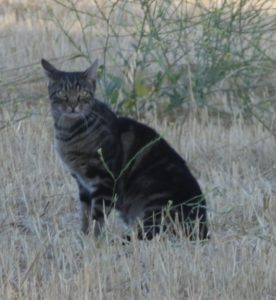 Gorman, author of an article published in the New York Times in February, there were 2,850,000 results for dogs and only 1,670,000 for cats. That surprises me, actually. It seems like the Internet is brimming with cats. But perhaps I’m thinking of cute videos and the reporter was searching for something more specific.
Gorman, author of an article published in the New York Times in February, there were 2,850,000 results for dogs and only 1,670,000 for cats. That surprises me, actually. It seems like the Internet is brimming with cats. But perhaps I’m thinking of cute videos and the reporter was searching for something more specific.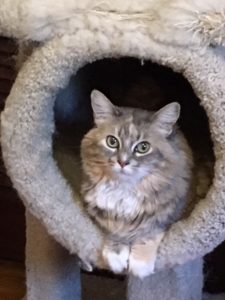 Cats seem to be taking over the Internet. Is it just me or has there been an enormous increase in cat-related posts, articles, videos, and so forth? I still maintain that the Internet has been good for the cat. People, who may have never paid much attention to cats are learning volumes about them. They’re smiling and even laughing at the sweet videos and photos of cats and kittens. They’re feeling sympathy toward abused and forgotten cats and understanding more about the species.
Cats seem to be taking over the Internet. Is it just me or has there been an enormous increase in cat-related posts, articles, videos, and so forth? I still maintain that the Internet has been good for the cat. People, who may have never paid much attention to cats are learning volumes about them. They’re smiling and even laughing at the sweet videos and photos of cats and kittens. They’re feeling sympathy toward abused and forgotten cats and understanding more about the species.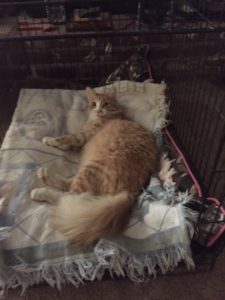 of the Internet. Are people looking at the stray cats in their neighborhood with more kindness and, perhaps, offering a little help? And what have you learned about your fluffy housemate since the Internet came into play?
of the Internet. Are people looking at the stray cats in their neighborhood with more kindness and, perhaps, offering a little help? And what have you learned about your fluffy housemate since the Internet came into play?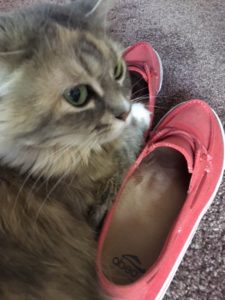 Just about every time I post here I learn something new from an expert or professional or just by talking about some of my own experiences and thoughts. Another thing I learn every time I post is how much more I have to learn. How about you? How has the Internet influenced your relationship with your own cats, the way you look at the species, and/or your level of interest in a particular cat-related issue or breed, for example?
Just about every time I post here I learn something new from an expert or professional or just by talking about some of my own experiences and thoughts. Another thing I learn every time I post is how much more I have to learn. How about you? How has the Internet influenced your relationship with your own cats, the way you look at the species, and/or your level of interest in a particular cat-related issue or breed, for example?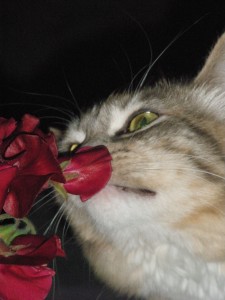 Cats and flowers seem to go together. A bouquet or garden of flowers is just the right background or foreground for cat photography. And a picture of flowers really comes to life when there’s a cat present.
Cats and flowers seem to go together. A bouquet or garden of flowers is just the right background or foreground for cat photography. And a picture of flowers really comes to life when there’s a cat present.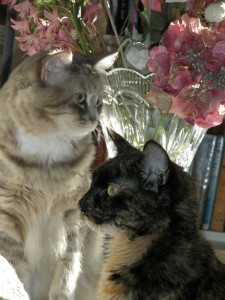 chrysanthemums, daisies, and amaryllis are toxic to cats? And gardenias, iris, jade plant, pothos, tulip and narcissus bulbs as well as daffodils and—yes, it’s true—marijuana.
chrysanthemums, daisies, and amaryllis are toxic to cats? And gardenias, iris, jade plant, pothos, tulip and narcissus bulbs as well as daffodils and—yes, it’s true—marijuana.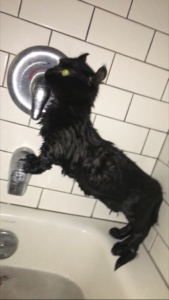 Does your cat drink water? You may have read that cats don’t typically drink much water and maybe that’s because they weren’t bred to. Their ancestors lived in the wilds and they got enough moisture in their prey. So it really is against a cat’s nature to be attracted to water. Except for maybe the fishing cat, the Turkish van and some of the big cats that live in very hot, arid climates. Not only do these cats tend to drink more water, but they will take a dip to cool off.
Does your cat drink water? You may have read that cats don’t typically drink much water and maybe that’s because they weren’t bred to. Their ancestors lived in the wilds and they got enough moisture in their prey. So it really is against a cat’s nature to be attracted to water. Except for maybe the fishing cat, the Turkish van and some of the big cats that live in very hot, arid climates. Not only do these cats tend to drink more water, but they will take a dip to cool off.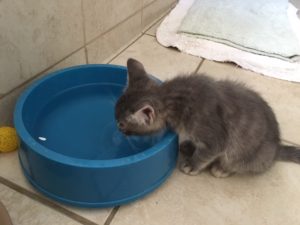 Winfield loved to play in his water bowl—pawing at the water, splashing in it, spilling it. And he drank with his paw. He’d dip his paw into the water and lick the water off his paw.
Winfield loved to play in his water bowl—pawing at the water, splashing in it, spilling it. And he drank with his paw. He’d dip his paw into the water and lick the water off his paw.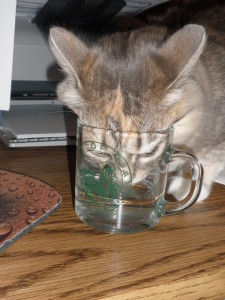 If you don’t think your cat is drinking enough water and especially if he or she is prone to urinary tract issues or has kidney problems, here are some tips:
If you don’t think your cat is drinking enough water and especially if he or she is prone to urinary tract issues or has kidney problems, here are some tips:
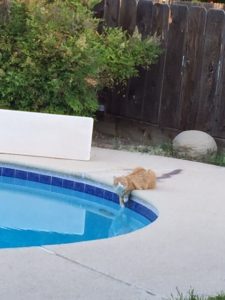
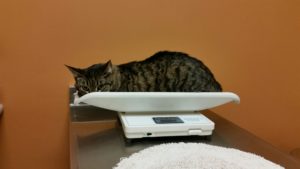 You (and your cat) may have heard it before. “Gosh she’s a fatty.” Or “I love fat cats—she’s so cute.” Or “Gads, what do you feed her?” Your veterinarian may be telling you to cut down on her food and treats and especially any salty, fatty table food. But how do you deny your sweet kitty the thing in life she most loves—food? And what about the multi-cat household—how do you put one or two cats on a diet when some of the others are actually underweight? These are good question that need answers.
You (and your cat) may have heard it before. “Gosh she’s a fatty.” Or “I love fat cats—she’s so cute.” Or “Gads, what do you feed her?” Your veterinarian may be telling you to cut down on her food and treats and especially any salty, fatty table food. But how do you deny your sweet kitty the thing in life she most loves—food? And what about the multi-cat household—how do you put one or two cats on a diet when some of the others are actually underweight? These are good question that need answers.




